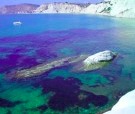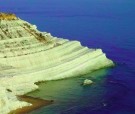|
|
 |
I PARCHI LETTERARI "IN THE DIMENSION OF THE JOURNEY"
- THE SEA
Here we are now, surrounded by the sea, having arrived
on this great island in the centre of the Mediterranean.
The first emotion of the journey, our first “amazement”,
today as in the past, comes from this splendid sea...
 “If
you have never been completely surrounded by the sea,
you cannot understand the world and our relationship
with it. That grand yet simple line inspired me with
completely new thoughts... There are no words to
describe the vaporous clarity that hovered along
the coastline on the stupendous afternoon of our arrival,
the purity of the surroundings, the softness of
everything, the range of nuances, the harmony that
joined the sky, the sea and the land. Those who have
seen it will keep it in their hearts for their entire
lives.” (Goethe, “Italian Journey”).) “If
you have never been completely surrounded by the sea,
you cannot understand the world and our relationship
with it. That grand yet simple line inspired me with
completely new thoughts... There are no words to
describe the vaporous clarity that hovered along
the coastline on the stupendous afternoon of our arrival,
the purity of the surroundings, the softness of
everything, the range of nuances, the harmony that
joined the sky, the sea and the land. Those who have
seen it will keep it in their hearts for their entire
lives.” (Goethe, “Italian Journey”).)
The Turkish Steps
Realmonte is a small town located on a plain near
the sea.
The Turkish Steps rise up between the beach and the
chalky hills that delineate the coastline.
The Steps are lovely sea cliff of marl, a fine-grain
sedimentary rock composed of limestone and clay, with a
distinctive white colour, into which the wind and rain
have carved a natural staircase.
 They
offer a unique spectacle; the whiteness of sea cliff is
rendered even more brilliant by the sun’s rays between
the azure sky and the blue sea: a genuine paradise.
According to ancient legend, Saracen pirates, after
having moored their ships in the waters protected by the
Steps, climbed among the nooks and crannies, reaching
the top of the cliff. They
offer a unique spectacle; the whiteness of sea cliff is
rendered even more brilliant by the sun’s rays between
the azure sky and the blue sea: a genuine paradise.
According to ancient legend, Saracen pirates, after
having moored their ships in the waters protected by the
Steps, climbed among the nooks and crannies, reaching
the top of the cliff.
Then they pillaged all of the villages in the area.
It is highly improbable that the Turks arrived at this
location, but the legend remains. There is another
legend associated with the Turkish Steps: about two
hundred metres from the shore, two rocks rise up, “u
zitu” and “a zita”, which tell the tale of two young
lovers from this area.
Actually, the sea, which is a symbol of life and passion,
of legend and metaphor, with its colours, the beauty of
the coastline and its bathing areas, only adds to the
charm and suggestion of the treasures found in the
Province of Agrigento. Here there is an extended
coastline that faces the African Sea, which contains
some precious pearls.
“We took a walk down to the sea, from where, as the
old folk say, the view of Girgenti was very beautiful at
one time. The gaze is captured by the liquid immensity…
towards the south there was a long ribbon of clouds that
seemed to lie along the horizon like a mountain crest;
it was the headland of the African coast.”
(Goethe)
“A subtle arch of feathery clouds rested on Sicily on
one end and curved above the blue of the sky, which was
otherwise perfectly clear, while at the southernmost
point it seemed to rest on the sea; coloured by the
beautiful rays of the sun at dusk, it moved very slowly,
with an effect that was as unique as it was fascinating.
The arch pointed exactly in the direction of Malta;
indeed, the other end probably rested on that island, a
phenomenon that was known to sometimes occur. It would
have been quite interesting for the atmosphere to have
displayed the reciprocal attraction of these two islands
in such a way.” (Goethe)
“To the left was an expanse of open sea, as splendid
as a mirror. Reddened by the sun’s rays at dusk, the
light reflected on the rocky mountains that obstructed
the view to the right. The descent towards the sea was
decorated with majestic ruins among the fields of wheat,
where a perfectly preserved temple of rare beauty and
simplicity rose up. On one side there was a row of tombs,
on the other the ruins of the ancient bastions snaked
along, further on, in a straight line up to the sea, the
columns of magnificent simplicity and strength stretched
out, and even in their sad desolation, represented
indescribable splendour, richness and beauty” (Bartels)
|



